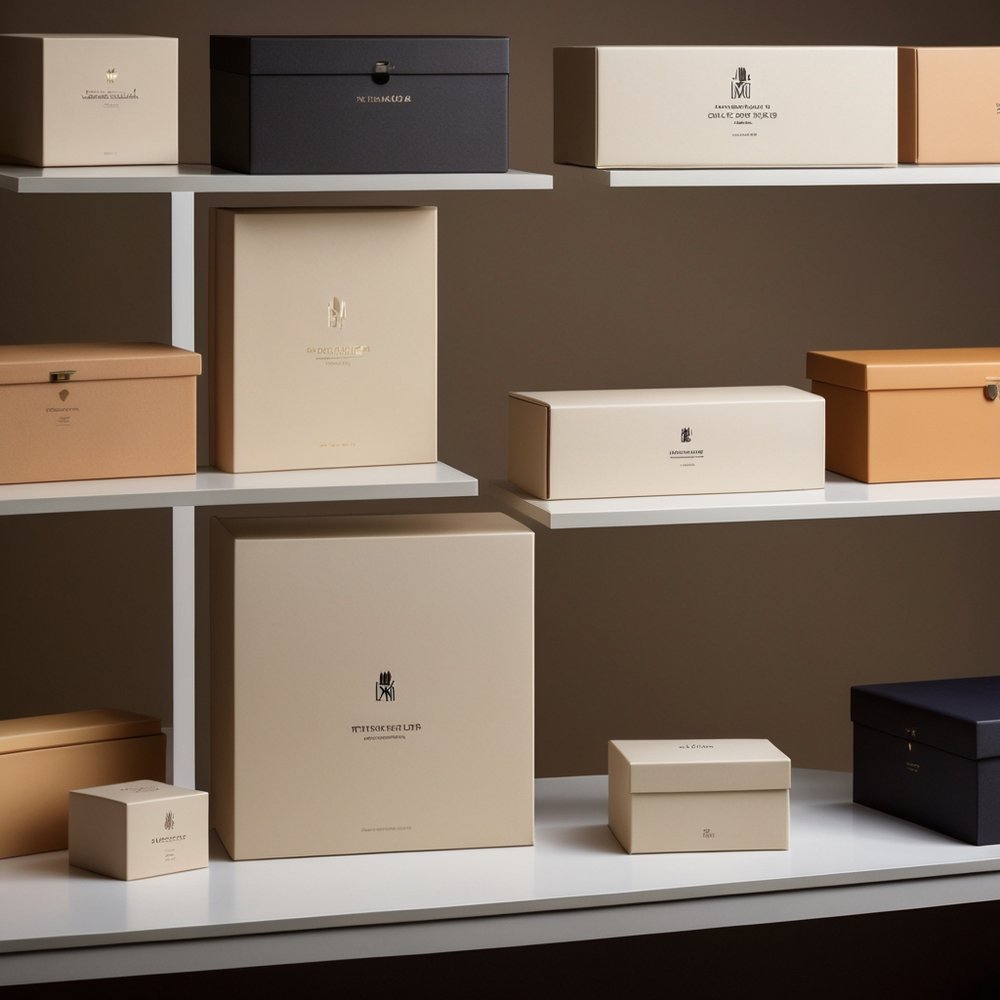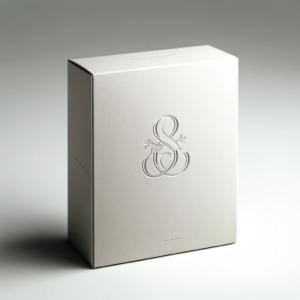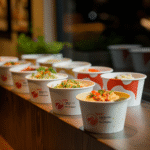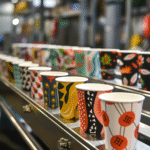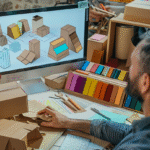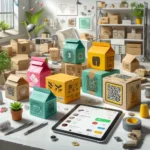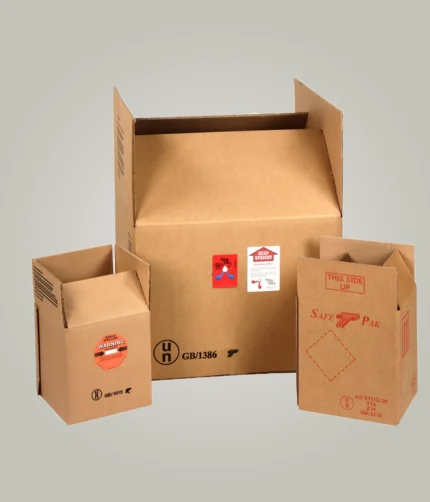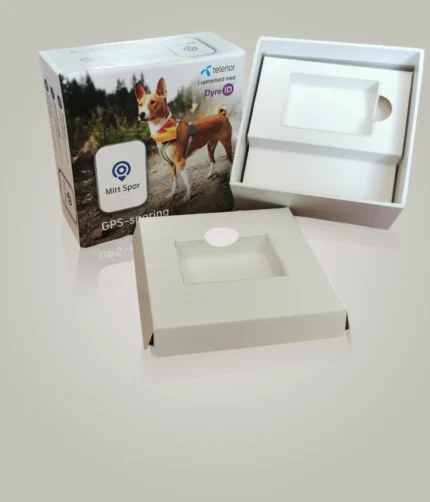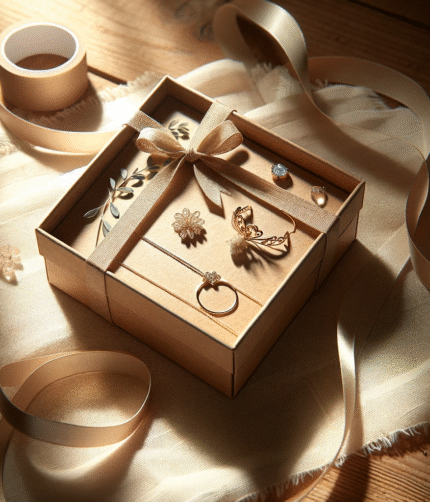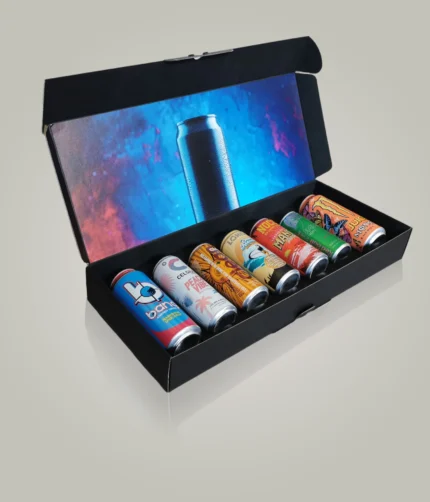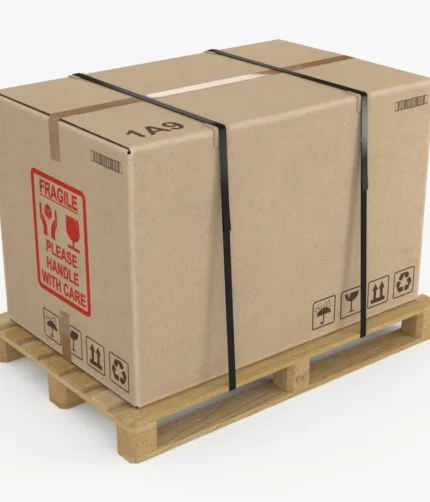Introduction: The Shift to Branded Boxes
In today’s highly competitive market, businesses are constantly searching for ways to stand out and create lasting impressions. One of the most powerful yet often overlooked tools in this effort is branded packaging. As more companies realize the importance of packaging not only as a functional necessity but also as a vital element of brand identity, the demand for branded boxes is on the rise. Packaging is no longer just about protecting the product; it’s about telling a story, reinforcing the brand, and creating an unforgettable experience for the consumer.
The shift to branded boxes reflects the growing understanding that first impressions matter. When customers receive a product in a thoughtfully designed, high-quality branded box, it immediately adds value to their experience. Whether it’s through printed boxes that showcase a brand’s logo or personalised packaging that reflects the uniqueness of the product inside, packaging has become a strategic asset for businesses of all sizes.
This article explores the key features of branded boxes, the benefits of printed boxes, and how companies can leverage personalised packaging to enhance their brand’s visibility and connect with their audience in meaningful ways. From product protection to marketing and sustainability, branded boxes play a pivotal role in the modern business landscape.
Key Features of Branded Boxes
Branded boxes come in a wide variety of styles and materials, each designed to meet specific business needs. Whether a company is seeking a minimalist, eco-friendly look or a luxurious, high-end feel, the right branded box can significantly enhance the product’s presentation and protection. Below are some of the key features that businesses should consider when selecting branded boxes for their products.
- Types of Branded Boxes
The most common types of branded boxes include:
- Corrugated Branded Boxes: These are highly durable and perfect for protecting fragile items during shipping. Corrugated boxes can be easily customized with prints, logos, and brand colors, making them a great choice for businesses looking to combine strength and visual appeal.
- Rigid Branded Boxes: Typically used for luxury items, rigid boxes offer a premium feel and superior durability. Their sturdy construction makes them ideal for high-end products like cosmetics, perfumes, and jewelry, where the packaging must convey exclusivity and value.
- Eco-Friendly Branded Boxes: As sustainability becomes a key concern for consumers, businesses are increasingly opting for eco-friendly branded boxes. Made from recyclable or biodegradable materials, these boxes not only help reduce environmental impact but also resonate with environmentally-conscious customers.
- Customization Options
One of the most appealing aspects of branded boxes is the range of customization options available. Businesses can create unique printed boxes that feature their logo, brand colors, and even custom graphics. This helps to reinforce the brand’s identity and makes the product stand out on the shelves. Personalization can go beyond just print, with options like embossing, foil stamping, or adding unique finishes like matte or gloss. - Durability and Protection
While the visual appeal of branded boxes is important, they must also provide adequate protection for the product inside. This is particularly true for e-commerce businesses, where products are often shipped long distances. Durable packaging not only protects the product but also ensures that customers have a positive unboxing experience, reinforcing the brand’s commitment to quality. - Sustainability
Sustainability is now a top priority for many brands. Choosing eco-friendly materials like recycled cardboard or using water-based inks for printing can significantly reduce the environmental footprint of branded boxes. Additionally, businesses that use sustainable packaging can enhance their brand image by aligning with the values of eco-conscious consumers.
Branded boxes are more than just a packaging solution; they are a vital part of a brand’s overall identity. Whether focusing on luxury, sustainability, or protection, businesses have endless opportunities to create customized packaging that truly represents their brand values.
Printed Boxes: Making a Statement with Custom Design
Printed boxes have become an essential part of modern branding strategies. Beyond their functional role of protecting the product, they serve as a canvas for brands to communicate their identity and values. A well-designed printed box can significantly impact a customer’s perception of a brand and leave a lasting impression.
- The Benefits of Printed Boxes
Custom printed boxes offer several key benefits to businesses:
- Brand Visibility: Printed boxes provide an opportunity to showcase a company’s logo, tagline, and colors, creating instant recognition. When customers see a well-designed printed box, they are more likely to associate it with the brand, increasing brand recall.
- Customer Attraction: Packaging is often the first point of interaction between a brand and a customer. A creatively designed printed box can attract attention, making the product stand out on crowded shelves or in the competitive e-commerce space.
- Enhanced Perceived Value: High-quality printing and unique designs can elevate the perceived value of a product. Consumers often associate premium packaging with premium products, making printed boxes a powerful tool for luxury brands.
- Best Practices for Designing Printed Boxes
Designing effective printed boxes requires a careful balance between creativity and functionality. Some best practices include:
- Logo Placement: A prominent, well-positioned logo on the printed box ensures that the brand is easily recognizable. Logos should be strategically placed to catch the eye, whether on the front, top, or sides of the packaging.
- Color Schemes: Colors play a critical role in brand recognition. Using consistent brand colors on printed boxes helps create a cohesive brand image. It’s important to choose colors that not only reflect the brand’s identity but also resonate with the target audience.
- Typography: The choice of fonts and text layout can influence how consumers perceive a brand. Bold, clean typography enhances readability and contributes to a professional appearance, while decorative fonts can add a touch of elegance or playfulness, depending on the brand’s personality.
- Finishing Touches: Beyond print, additional finishes such as gloss, matte, or foil stamping can enhance the visual appeal of printed boxes. These finishes give the packaging a premium look and feel, adding to the overall customer experience.
- Case Studies: Brands Using Printed Boxes Effectively
Several businesses have successfully used printed boxes to enhance their brand presence:
- Apple: Apple’s minimalist, sleek printed boxes are iconic in the tech world. The clean design, crisp logo placement, and high-quality finishes have made their packaging a benchmark for premium brands.
- Glossier: This beauty brand uses soft pinks and playful typography on its printed boxes, creating an instantly recognizable aesthetic that appeals to its target audience.
- Harry’s: The shaving brand Harry’s incorporates bold colors and simple graphics on its printed boxes, reflecting its modern, no-nonsense approach to grooming products.
By incorporating these design elements, businesses can create printed boxes that not only protect their products but also make a powerful branding statement. Whether in retail stores or online orders, printed boxes are an essential tool for capturing attention and fostering brand loyalty.
Brand Packaging as a Strategic Tool
Brand packaging has evolved into a critical part of a company’s overall marketing strategy. Beyond serving its primary purpose of protecting the product, branded boxes and packaging can influence how consumers perceive the brand and their purchasing decisions. Smart packaging design enhances the brand experience and aligns with a company’s broader goals.
- How Branded Boxes Contribute to Brand Strategy
Branded boxes go beyond aesthetics—they play an integral role in shaping a brand’s image. Every element of the packaging, from materials to design, reflects the brand’s values and identity. For example:
- Consistency Across Product Lines: Consistent packaging across various products helps reinforce brand recognition. Whether it’s a luxury skincare line or everyday household products, using similar branding elements in packaging strengthens the brand’s visual identity.
- Differentiation in a Competitive Market: Custom branded boxes allow businesses to stand out from competitors. By incorporating unique design elements, such as distinct colors, creative logos, or specific materials, brands can differentiate themselves in the crowded market and create a memorable customer experience.
- Emotional Connection with Customers: Thoughtfully designed packaging can evoke emotions, which in turn can build stronger connections between the brand and its customers. For example, brands that focus on eco-friendly packaging may attract customers who value sustainability, thus fostering brand loyalty.
- Packaging as a Marketing Campaign
Branded boxes can be leveraged as part of broader marketing campaigns. Brands are increasingly using packaging to communicate key messages and engage with consumers.
- Seasonal or Limited-Edition Packaging: Many companies launch limited-edition or seasonal packaging to generate excitement around their products. This type of packaging not only encourages impulse buying but also creates a sense of exclusivity, which can drive customer engagement and sales.
- Collaborations and Co-Branding: Packaging is a great way to highlight collaborations between brands. When two well-known brands come together to create a product, custom printed boxes reflecting the partnership can create buzz and appeal to a wider audience.
- Examples of Brands Utilizing Packaging Strategically
- Coca-Cola: Coca-Cola has famously used limited-edition packaging to create buzz, especially with their “Share a Coke” campaign, where they printed names on bottles and cans. This clever use of personalized packaging helped engage customers on a more personal level.
- Lush: The cosmetics brand Lush uses eco-friendly, minimalist packaging that reflects its commitment to sustainability. Their branded boxes not only communicate the brand’s values but also create an authentic connection with environmentally conscious customers.
- Tiffany & Co.: Tiffany’s distinctive robin’s egg blue box has become a symbol of luxury and elegance. This iconic branded box instantly elevates the perceived value of their jewelry and enhances the overall unboxing experience, turning the packaging itself into a key marketing asset.
- The Future of Branded Packaging in Marketing
As more brands recognize the strategic importance of packaging, branded boxes are becoming more sophisticated, interactive, and engaging. Technology is playing a role too, with innovations like QR codes and augmented reality integrated into packaging designs. These interactive elements encourage customers to engage further with the brand, providing a more immersive experience that extends beyond the physical product.
Branded packaging is no longer just a means of delivering products—it’s a critical marketing tool that helps businesses connect with consumers, build loyalty, and differentiate themselves from competitors. By strategically using branded boxes, companies can turn packaging into a powerful extension of their brand identity.
Maximising Personalisation in Branded Boxes
In today’s consumer-driven market, personalisation has emerged as a key differentiator for brands. Personalised packaging allows businesses to tailor their branded boxes to meet specific customer needs, creating unique experiences that resonate on a personal level. Whether it’s through custom graphics, messages, or special designs, personalised packaging can significantly enhance customer loyalty and brand engagement.
- The Rise of Personalised Packaging
Consumers today expect more than just a functional product—they want an experience that feels personal and unique. Personalised packaging has become a powerful way for brands to meet these expectations:
- Tailored Designs: Custom designs allow businesses to create packaging that reflects their customers’ tastes and preferences. From personalized prints to custom shapes and sizes, brands can use branded boxes to deliver a one-of-a-kind experience.
- Variable Data Printing: Advances in printing technology have made it possible to create highly personalized packaging at scale. Variable data printing allows brands to print unique designs or messages on each box, making every package feel special.
- How Personalised Packaging Strengthens Customer Relationships
Customised branded boxes not only enhance the unboxing experience but also help build stronger relationships with customers:
- Brand Loyalty: When customers feel that a brand has gone the extra mile to personalize their packaging, they are more likely to develop a sense of loyalty. Personal touches, like a customer’s name on the packaging or a thank-you note, create emotional connections that go beyond the product itself.
- Customer Engagement: Personalised packaging encourages engagement. Brands can use packaging to share messages, promote special offers, or encourage customers to interact on social media. For example, a hashtag printed on the box can inspire customers to share their unboxing experiences online, creating a ripple effect that boosts brand visibility.
- Exclusivity: Personalisation adds a sense of exclusivity to a product. Limited-edition branded boxes, custom designs, or packaging that reflects a particular customer’s preferences can make the product feel more valuable and special.
- Personalisation Trends in the Packaging Industry
Several key trends are shaping the future of personalised packaging, offering brands new ways to connect with their audiences:
- Sustainable Personalisation: As sustainability becomes more important to consumers, eco-friendly materials are being integrated into personalised packaging designs. Brands are finding ways to offer customised branded boxes while also meeting their environmental goals, such as using recycled materials or biodegradable inks.
- Interactive Packaging: QR codes, augmented reality (AR), and other digital elements are becoming common in personalised packaging. These technologies allow customers to engage with the brand in new ways, such as scanning a code on the box to access exclusive content or personalized messages.
- Minimalist Personalisation: Simplicity is often the key to creating a memorable experience. Brands are adopting minimalist designs in their personalised packaging, focusing on clean, modern aesthetics that let the product speak for itself while still offering a personalised touch.
- Case Studies: Brands Leveraging Personalised Packaging
- Nike: Nike has used personalised packaging to strengthen its relationship with customers, especially through its Nike By You program, where customers can design their own shoes and receive them in custom branded boxes that reflect their design choices.
- Moonpig: As a personalised greeting card company, Moonpig allows customers to fully customise their packaging, from the card design to the box it comes in. This personalisation ensures a unique experience for every customer.
- Coca-Cola: Coca-Cola’s “Share a Coke” campaign is one of the most well-known examples of personalised packaging. By printing names on bottles, Coca-Cola created a personal connection with customers that led to increased engagement and sales.
- The Future of Personalised Packaging
As brands continue to seek new ways to connect with their customers, personalised branded boxes will play an even more significant role. Advances in technology will make it easier to create custom packaging at scale, while the push for sustainability will encourage brands to find innovative ways to personalise eco-friendly materials.
Personalisation is not just about adding a customer’s name to the packaging; it’s about creating a tailored experience that makes customers feel valued. By embracing personalised packaging, brands can enhance customer loyalty, increase engagement, and create a lasting impression in an increasingly competitive market.
Conclusion: The Future of Branded and Personalised Packaging
As consumer expectations continue to evolve, branded packaging has become more than just a way to protect products—it is a critical element of a company’s brand strategy. Branded boxes play a central role in shaping a brand’s identity, fostering customer loyalty, and differentiating products in a crowded marketplace. Whether through custom printed boxes that enhance visibility or personalised packaging that delivers a unique, tailored experience, brands can use packaging to leave a lasting impression.
In an increasingly competitive environment, businesses that invest in high-quality, strategically designed branded boxes are more likely to thrive. The shift toward personalisation has transformed packaging into an opportunity to engage customers on a deeper level. Consumers appreciate thoughtful design, and when a package feels personal or exclusive, it elevates the product inside, making the entire experience more memorable.
Sustainability is also becoming a key factor in packaging decisions. As customers become more eco-conscious, brands need to find innovative ways to combine personalisation with environmentally friendly materials. The demand for sustainable branded boxes is on the rise, and brands that prioritize this will not only reduce their environmental footprint but also appeal to a growing audience of sustainability-minded consumers.
Looking ahead, technology will continue to play a significant role in the future of packaging. Interactive elements like QR codes, augmented reality, and digital personalization will allow brands to further connect with their customers beyond the physical product. These tools will help create immersive, multi-sensory brand experiences that extend beyond the unboxing moment.
In conclusion, the future of branded boxes lies in the fusion of personalisation, sustainability, and innovation. Companies that can effectively integrate these elements into their packaging will set themselves apart in the market, offering more than just a product—they will offer an experience that resonates with their customers long after the box is opened.
If you’re looking to elevate your packaging strategy, don’t hesitate to reach out to Pack Expert OU. Send us your request, and we’ll help you create the perfect branded packaging solution that suits your brand’s needs and vision.

